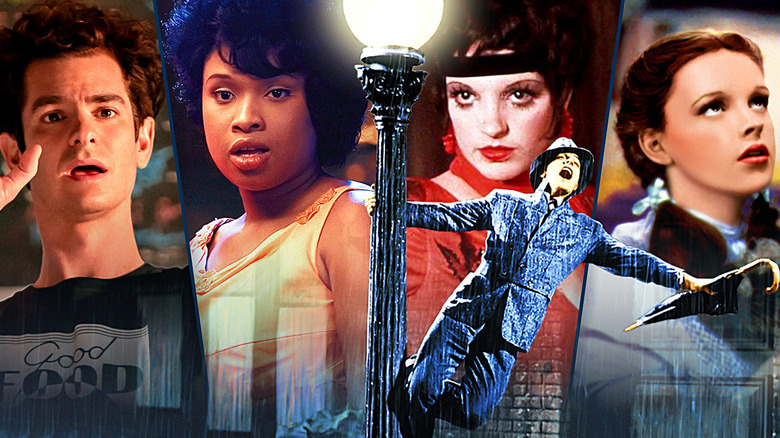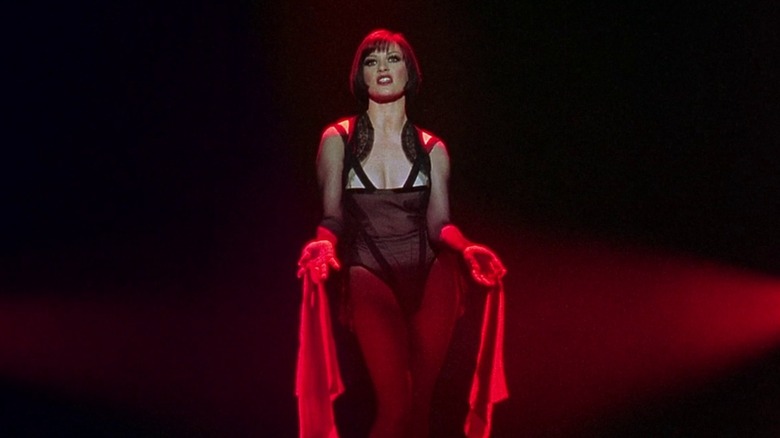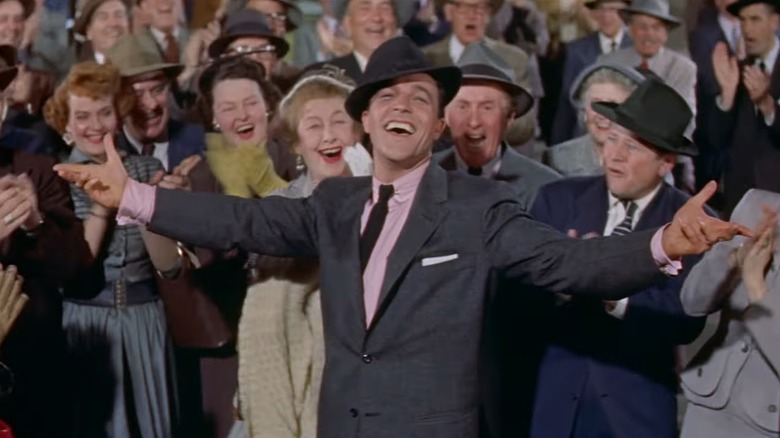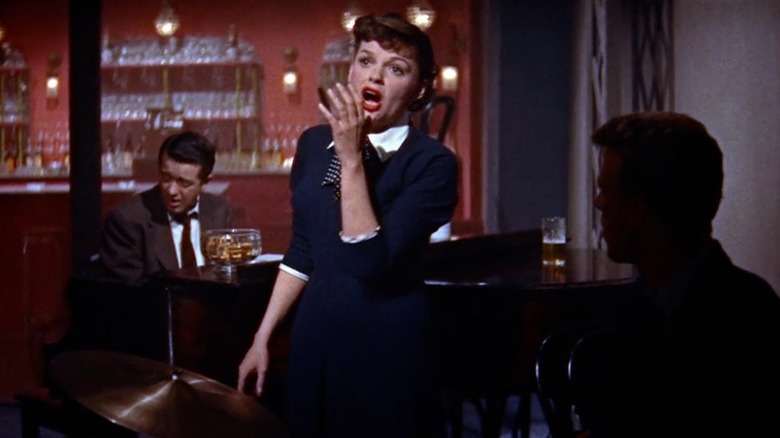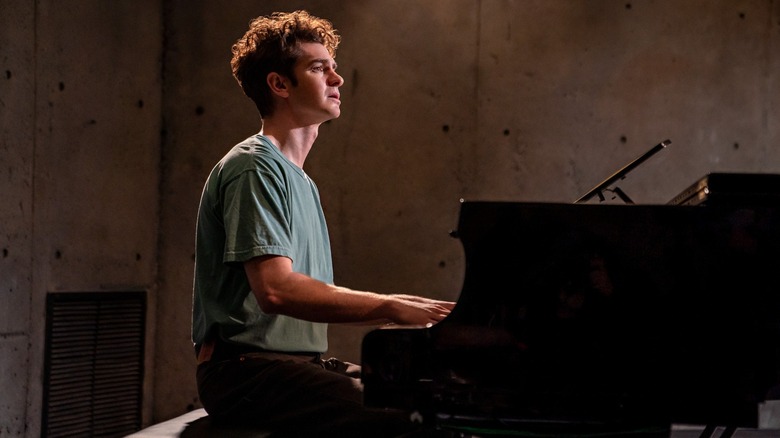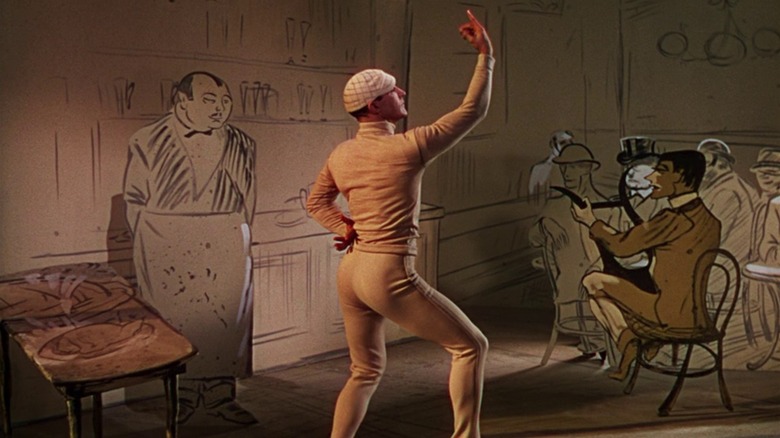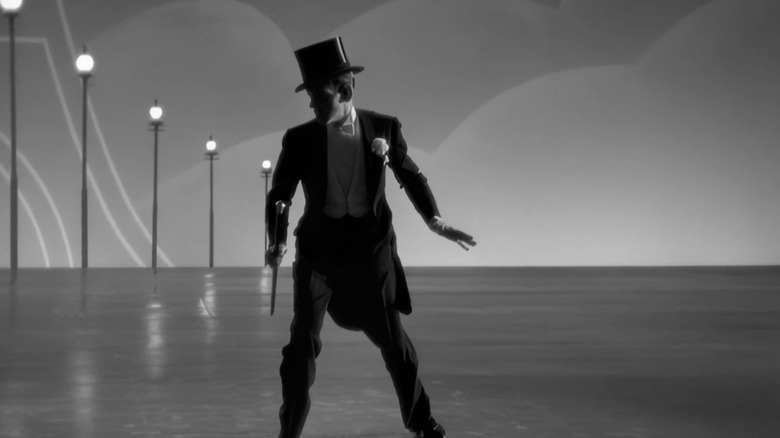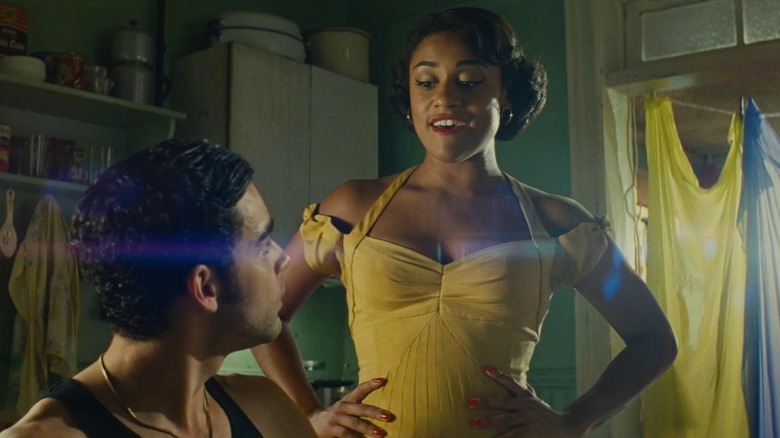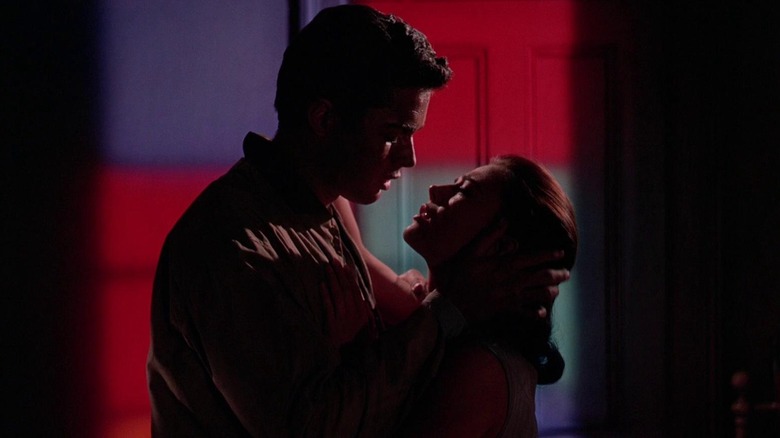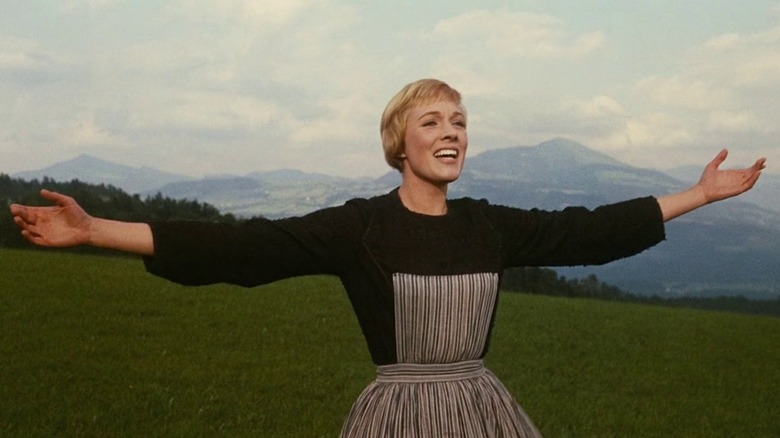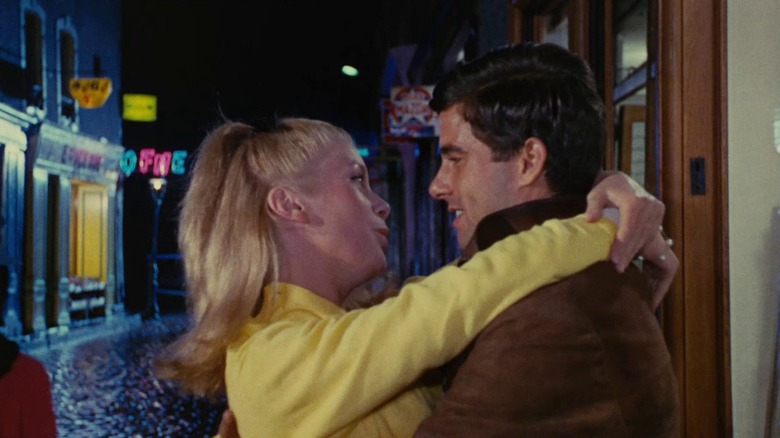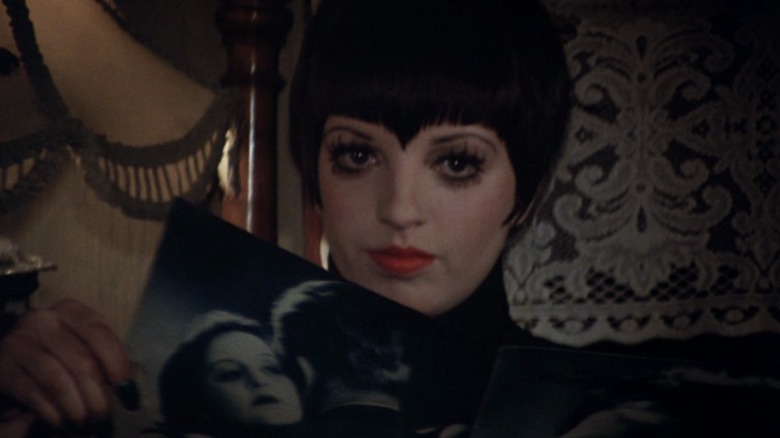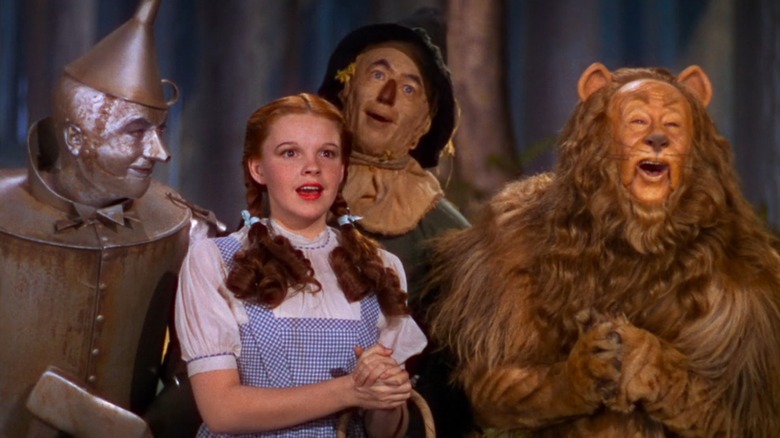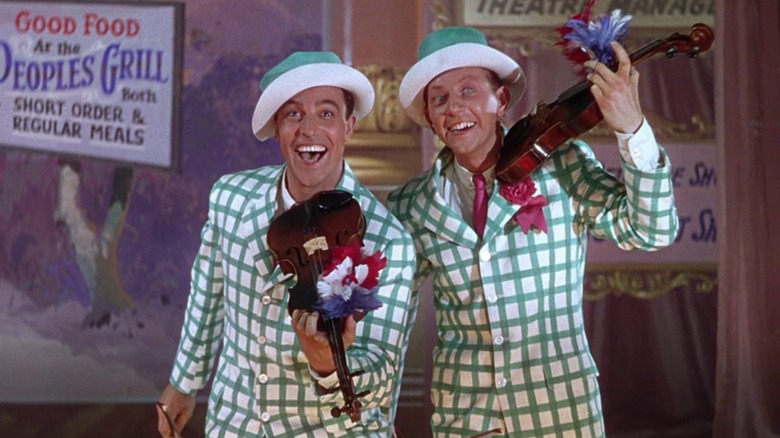15 Best Movie Musicals Of All Time, Ranked
We may receive a commission on purchases made from links.
In the preface to her seminal book "The Hollywood Musical," Jane Feuer argues that musicals deserve as much serious consideration by film theorists as any other genre. After all, she says, just because they're mass entertainment doesn't mean they're not doing something worthwhile beneath the surface. "Musicals not only gave the most intense (because the least intellectualized) pleasure to their audience but also supplied a justification for that pleasure," she wrote. "Musicals not only showed you singing and dancing; they were about singing and dancing, about the nature and importance of that experience."
She's right. The best musicals insist that the cathartic release of singing and dancing is a worthwhile pursuit all its own. The best musicals lean into the excitement of spectacle, reminding us that coming together to watch people perform can be one of the most energizing forms of entertainment we have. Feuer even argues that the Hollywood musical resembles folk art, often aiming to tap into something primal within society, saying something pure about our wish to entertain one another as a form of community ritual. The best movie musicals of all time, then, aim to provide pure entertainment, even as they sometimes subvert the form in fascinating ways.
15. Moulin Rouge! (2001)
Depending who you ask, Baz Lurhamnn reinvented the musical with "Moulin Rouge!" It's essentially a jukebox musical, but it's one that transports contemporary pop songs to Paris at the close of the 1800s. It's the story of an idealistic writer named Christian (Ewan McGregor), a lovesick puppy dog of a man who falls madly for a courtesan named Satine (Nicole Kidman).
If the best musicals are about spectacle as a worthwhile communal ritual in and of itself, then "Moulin Rouge!" is the equivalent of taking a confetti cannon straight to the face. Lurhmann fills every frame with extravagance and glitter, every scene all sparkling diamonds and lush fabrics. (Diamonds are, after all, a girl's best friend).
There are a number of memorable sequences in "Moulin Rouge!," but "The Elephant Love Medley" is the standout. McGregor and Kidman flirt by running through a series of swooningly-romantic pop song lyrics, weaving together their romance out of the magic of music. You simply have to buy in, because it's clear that everyone involved in this production believes.
14. Chicago (2002)
People who say they dislike musicals because they don't understand why everyone's always singing — in other words, annoying people who performatively refuse to suspend their disbelief — are missing out on the ways that various film musicals try to overcome this barrier. In Rob Marshall's Best Picture-winning 2002 film version of "Chicago," the majority of the musical numbers take place in a dream space. The characters perform in a self-consciously-stagey void, a reminder of the musical's Broadway origins even as the magic of film editing lets us understand the numbers as emotional reflections of a more "realistic" plane of reality.
Plus, it's just fun. There are few numbers in the musical canon as electrifying as "The Cell Block Tango," and the film's version of the number is riveting. As we cycle through all of these merry murderesses telling their stories, we see them re-enacting their crimes in flashback and also re-interpreting them through the magic of Bob Fosse-style jazz hands. It's a great example of what the Hollywood musical can do.
13. It's Always Fair Weather (1955)
"It's Always Fair Weather" is sort of a spiritual sequel to "On the Town." Whereas that musical followed three sailors on a wild leave weekend in New York City, "It's Always Fair Weather" — also directed by Gene Kelly and Stanley Donen — reunites three buddies ten years after their military service. They take stock of their lives, make halting attempts at reconciliation, and embark on new romances, and the musical is unusual because it's aiming for something more melancholy than most others.
Still, there's incredible spectacle to be found here, too. During one early number, the guys (Gene Kelly, Dan Dailey, and Michael Kidd) bumble drunkenly through the streets of New York, even strapping garbage can lids to their feet to serve as tap shoes. "Stomp," eat your heart out!
"I Like Myself" is one of the most sweetly-romantic numbers in all of musicaldom. Kelly's character is so overcome with the giddiness of love that he leaves a roller rink with his skates still on, and a crowd gathers around him as, oblivious, he glides around the sidewalks. When he realizes he's got an audience — which is unusual for a musical! — Kelly performs an elaborate tap routine on skates. It's all shot in very few takes, a perfect example of the way the best musicals choreograph the camera as much as they do their dancers.
12. A Star is Born (1954)
Each musical version of "A Star Is Born" is great. The Lady Gaga version's got the best songs and Barbra Streisand is undeniable, but the 1954 film starring Judy Garland still towers above the other two. She plays Esther Blodgett, a nightclub singer who meets an actor named Norman Maine (James Mason). As they fall in love and her career takes off, he succumbs to alcoholism and depression. As with many musicals on this list, it's about fame and celebrity, the allure of performance, and the damaging nature of failed romance.
And, my god, Judy Garland. As with the other versions, this "A Star Is Born" is also about her off-screen persona. She'd been famous for decades at that point — this list could reasonably have been made up of nothing but Judy Garland movies — and she'd gone through some highly-publicized troubles in the years leading up to this movie. When she stands up and sings a torch song like "The Man That Got Away," it's triumphant not just because the character's voice is great, but because we're so proud of Garland for pulling it together and turning out a performance like this. "Suddenly you're older," she sings, and what a gift it is to see an older Garland kill it like she used to.
11. tick, tick... BOOM! (2021)
Jonathan Larson's story is one of the great tragedies of musical theater. The man behind "Rent" died the day before its first performance, never living long enough to realize the fact that he'd created an enduring work of art. "tick, tick... BOOM!" is his other musical, an autobiographical look at a starving artist struggling to say something worthwhile. In 2021, Lin Manuel Miranda directed a film version for Netflix, creating a great work of art all his own.
Like "A Star Is Born," which is so successful in part because of Judy Garland's extra-textual story, "tick, tick... BOOM!" is a stunning vehicle for a performer throwing himself into the work just as his character does. Andrew Garfield gives an Oscar-worthy performance in "tick, tick... BOOM!" Although he's one of the best dramatic actors of his generation, it wasn't until "tick, tick... BOOM!" that he tried his hand at singing and dancing. You can see the work on screen; both Garfield and his character are men who believe wholeheartedly in what they're doing, to the point where they will drag art out of their bodies kicking and screaming.
10. An American in Paris (1951)
In "An American in Paris," one of the best Gene Kelly movies, he plays an American artist, a G.I. who settled in France after the war. The musical is about his attempt to find community in a place away from home; see, for example, "I Got Rhythm," which finds Kelly tap-dancing to entertain a bunch of adorable French children. "I got rhythm / I got music," he sings, a perfect distillation of Jane Feuer's aforementioned point. "Who could ask for anything more?"
The highlight of "An American in Paris" is its dream ballet, a feature of many stage musicals. This one is nearly twenty minutes long and wordless, featuring Kelly and Leslie Caron dancing through a series of elaborate sets painted to look like the work of various French artists. It's a stunning bit of stagecraft, especially because it's not stagecraft at all — it's a movie set. It's a sequence that reminds you that movie musicals shouldn't just recreate what it's like to see a show in person; they can, in fact, take the theatrical art form to the next level. Who could ask for anything more, indeed?
9. Top Hat (1935)
No overview of the best movie musicals would be complete without a mention of Fred Astaire and Ginger Rogers. The platonic ideal Astaire and Rogers movie is "Top Hat," the 1935 film that featured songs by Irving Berlin. It cemented many genre tropes, so much of what we would come to think of as classic musical clichés — the nightclub act, the elaborate tap dancing duets, and of course, Astaire and Rogers themselves as a pair. As the saying goes: she could do everything he could, backwards and in heels!
This is the movie that gave us "Cheek to Cheek." It's the movie that features the characters dancing "The Piccolino," a group number that perfectly encapsulates Jane Feuer's point about the release of dance as a communal folk ritual. Perhaps most strikingly, it draws its name from Astaire's performance of "Top Hat, White Tie, and Tails," which happens on The Great White Set that would come to define movie musicals for a long time. For part of the number, he's lit only in silhouette as he whirls around the stage, the very picture of elegance and grace.
8. Dreamgirls (2006)
Drawing inspiration from the real-life story of Diana Ross and The Supremes, "Dreamgirls" is a musical about the rise of a Motown girl group called, fittingly, The Dreams. Like many musicals, this one succeeds on the strength of some real powerhouse performances, including from none other than Beyoncé herself. Her rendition of "Listen" – an original song written for the movie — is so stunning that it charted on the Billboard Hot 100, and it made the Oscars change their rules.
The real glory, though, belongs to Jennifer Hudson as Effie White, the beating heart of the group. The "American Idol" contestant turned out to be a great dramatic actor, but it's her performance of the show-stopping "And I Am Telling You (I'm Not Going)" that provides the film's most exhilarating moment. It's such a landmark moment in movie-musical history, in fact, that lots of moviegoing audiences reportedly stood up and cheered at the end of the number ... even though, of course, Hudson was merely on screen and couldn't hear the standing ovations.
7. West Side Story (2021)
As mentioned above, the best movie musicals understand that the camera should be dancing with the performers, gliding and twirling too. It makes sense, then, that Steven Spielberg is the director to deliver the best modern movie musical with his remake of "West Side Story." Many modern musicals don't care about the images that make up their movies the way that Spielberg always does, and this remake finds the director moving his camera as fluidly as ever.
"West Side Story" is essentially a retelling of "Romeo and Juliet," reconfiguring the Shakespeare play as a battle between rival gangs of scrappy New York youth. Rachel Zegler is a full-fledged movie star now, but she was an unknown when Spielberg tapped her to play his Maria. He likewise jump-started the film careers of stage actors like Ariana DeBose and "Challengers" star Mike Faist, meaning just a few years later, "West Side Story" is already a killer "oh yeah, they're in this!" film. The less said about Ansel Elgort, though, the better.
6. West Side Story (1961)
Steven Spielberg's "West Side Story" is phenomenal, but there's no beating Robert Wise and Jerome Robbins's original for one simple reason: Technicolor. Spielberg's version is gorgeous, but it's disappointingly desaturated the way lots of movies are these days. The 1961 film, on the other hand, is filmed in eye-popping color, telling its emotional story through the vibrant, passionate reds and blues of Puerto Rican culture just as much as it tracks its characters through music and dance.
Rachel Zegler blows Natalie Wood out of the water — Wood is great, but she's essentially doing brownface, which is regrettable, to say the least. Otherwise, though, the original "West Side Story" is full of a number of killer performances that even the remake can't surpass. Rita Moreno won an Oscar for good reason for her portrayal of Anita, and future "Twin Peaks" cast member Russ Tamblyn is simply delightful as Riff.
5. The Sound of Music (1965)
Robert Wise directed a bunch of other musicals in addition to "West Side Story," including the dreadful "Rooftops." Still, his filmography includes one more certified masterpiece that's even better than "West Side Story" — "The Sound of Music." The musical finds Julie Andrews playing Maria, a nun who's hired as a governess to a large family of rambunctious aristocratic children.
The resulting film, which eventually tracks the real-life Von Trapp family singers as they flee Nazi-occupied Austria, is a classic if ever there was one. Just about every number is iconic, and if we're intentionally appreciating that musicals wrap a message into mass entertainment, it should be noted that for a while, "The Sound of Music" was the highest-grossing film of all time. Audiences all around the world have appreciated "The Lonely Goatherd," and they've all learned that there's no indulging Nazis, either. It's a message that's as timely as ever.
4. The Umbrellas of Cherbourg (1964)
Speaking of filmmakers who care about the images that make up their movies, Jacques Demy's "The Umbrellas of Cherbourg" is perhaps the perfect example of the musical's tendency toward style as substance. On the surface, this is a relatively simple story. Guy (Nino Castelnuovo) falls in love with Geneviève (Catherine Deneuve) but gets shipped off to war; by the time he returns, she's married someone else. Mon dieu!
In Demy's hands, however, this movie is a candy-coated wonderland, a world made up of beautifully soft colors that complement each other perfectly. It's about Guy and Geneviève's love, sure, but it's also about the specific yellow shade of her coat, and the shining pink and blue neon signs behind them when they pause to embrace on the street, and the pastel pink wallpaper in their homes, and the stunning orange café walls, and on and on. There's always something new to look at as the characters sing their way through life. Musicals are a heightened version of reality; if only reality was this comfortingly pretty.
3. Cabaret (1972)
Speaking of musicals about the dangers of placating Nazis, there's perhaps no musical as politically-urgent as "Cabaret." This is the story of the Kit Kat Klub, a rundown venue in pre-war Berlin where misfits and outcasts come together and celebrate their sensuality. It's the story of Sally Bowles (Liza Minnelli), a modern woman in every sense of the word, a woman who uses sex to get what she wants and isn't afraid to tell people that. It's the story of a bisexual love triangle, even, as Sally falls in with two men who want her and each other.
Bob Fosse's direction — which beat Francis Ford Coppola to the 1973 Oscar – imagines the cabaret as a place where people can escape the horrifying pressure of rising fascism. Most of the songs take place there, staged reflections of the characters' inner emotions. Still, by the time Sally sings the title number — Minnelli's eyes shining with tears of both fear and defiance — the outside world has crept in. The final shot is not only one of the most haunting musical images, but one of the most haunting images in all of cinema.
2. The Wizard of Oz (1939)
What is there to say about "The Wizard of Oz" that hasn't already been said? The 1939 film has been referenced, reimagined, and restaged so many times that it's far surpassed its source novel as the definitive telling of this story. A teenage Judy Garland made her mark on cinematic musical history with her role as Dorothy, her wide-eyed innocence perfectly inviting the audience in to the magical world of Oz.
This is such a perfect movie musical, in fact, that its transition from sepia-toned Kansas melancholy to Technicolor Oz-ian wonderland is often mistaken by children as having captured the moment the world itself changed from black and white to color. This wasn't the first color film, but it's the platonic-ideal use of cinema to elevate the musical art form in adapting it; you simply couldn't do that kind of transition on stage with the same impact.
And then, of course, there are the songs. From "Over the Rainbow" to "We're Off To See The Wizard," perhaps no other musical's songs so well represent the transportive power of musicals themselves. There's no denying Judy Garland, and there's no place like Oz.
1. Singin' in the Rain (1952)
"The musical is Hollywood writ large," Jane Feuer writes in "The Hollywood Musical." She notes that classic musicals aimed to sum up the entire history of popular entertainment, from vaudeville to Tin Pan Alley to burlesque, the circus, and more. With all of that in mind, there could be no other answer as to the best movie musical of all time than "Singin' in the Rain."
Gene Kelly and Stanley Donen's 1952 film is about the moment that Hollywood learned to talk, following a silent film actor as he tries to make his way in films that have sound. It's a jukebox musical that used popular songs so well that most people think they originated here, and it's all about the freeing power of breaking into song at any moment. When we watch Donald O'Connor clowning around in "Make 'Em Laugh" — one of the greatest movie musical songs — or admire Cyd Charisse's scarf fluttering out behind her on a movie set, or see Kelly himself singin' in the rain, we're watching the very essence of Hollywood celebrate its own transcendent effectiveness. To reference the title of a different movie altogether: that's entertainment.
